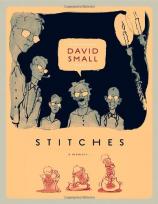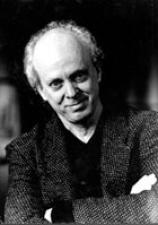Interview: September 18, 2009
September 18, 2009
Having made a name for himself writing and illustrating children's books for nearly three decades, award-winning author David Small recently turned his attention to more serious and personal matters, penning STITCHES, a memoir in graphic novel form that chronicles his childhood in an abusive and emotionally absent household. In this interview with John Hogan, the Editorial Director for GraphicNovelReporter.com, Small talks about what prompted this departure from his usual fare, and recalls both the traumatic and thrilling experiences of reliving such a painful period in his life. He also explains what he has since learned about his family that perhaps provides some insight into their behavior, and shares how his upbringing helped shape him into the artist he is today.
GraphicNovelReporter.com: STITCHES is powerful, amazing, and very different from what you usually do. Why do this book now? And why as a graphic memoir?
David Small: I was having bad dreams and I felt I needed therapy. To paraphrase Dante: Midway along the pathway of my life, I found myself in a dark forest because the straight way had been lost. It seemed like a good thing, at this point in my life, to drop all the metaphors and to examine my childhood as it really happened. I wanted to find out why I was still feeling, on some level, like a troubled boy of six.
But I didn’t want to go there alone. What I needed was someone to relive it with me; someone patient and loving and mature, who would indulge me while I fought through the jungle of my pent-up anxieties and who might help me to come out the other side with --- at the least --- a lessened sense of malaise. In other words, I needed a perfect parent, which is what --- ideally --- a psychoanalyst should be. (I had once had one of these, but that was 40 years ago. Then, I was really too young to appreciate what I had.)
Out here on the prairie, where we live, we’re a long way from that kind of help. I realized I was going to have to do it myself. So, as I began my book, I adopted the attitude of my old analyst: I stayed still, I watched and listened patiently to a lot of old garbage spilling out, and I sympathized with myself without getting maudlin about it.
Also, during all of this thrashing around --- and this is very important --- I always fully expected myself to get over it. I would have been disappointed if I’d come out of this intense period of reflection an even greater self-indulgent idiot than when I went into it.
In a sense, then, you see, I was always trying not to let myself down. I was applying the standards of making good art to my own self-psychoanalysis.
The graphic form --- the more I worked on it --- came to seem so right for my story. The reason for that is that my early home life was like living in a Soviet Bloc state. There, free speech was forbidden, honest language and opinions were a dangerous commodity. At any moment you might say the wrong thing and spark off some inexplicable punishment. You couldn’t trust anybody. So, in making my memoir, the fewer words I could use to tell my story --- the more pure watching I did --- the more true to the actual experience it became.
GNR: How did writing this book resolve the issues of your childhood? Or did it? In reality, can they ever be resolved?
DS: Let’s face it, a child whose mother did not love him or her lives his whole life with a hole in his heart. But, with the help of a trusted mate, friend, mentor --- even with that rarer thing, a truly caring therapist --- all of which I’ve been lucky to have at various times --- things can be modified. Life can get better. Also, art helps enormously.
GNR: Do you still feel any anger or resentment toward your family for what you went through?
DS: No. Now that, as an adult, I’ve brought them back from the dead, I can see them as human beings. I feel sad for them, but I’m no longer angry or --- in the case of my mother --- afraid of them anymore.
GNR: At the end of the book, you mention some of the things you learned about your mother after her death. Did you learn anything about either of your parents after their deaths that helped explain their behavior to you?
DS: My mother’s life was the big mystery. But yes, after she died, I found out that, a year after she married my father, she left him and went east to live with another woman, a longtime friend, in what used to be called a “Boston Marriage.” They were together two years. Then, for some reason --- probably money, because she was always terrified of being poor --- she went back to her doctor husband, had us two boys, and lived miserably ever after.
She wasn’t as brave or as “out” as her friend, but those were much different times.
GNR: Do you feel that you understand your parents now?
DS: I do understand them, which is maybe the only meaningful kind of forgiveness, but that doesn’t make me like them any better.
GNR: What is your relationship with your brother now?
DS: Better, because of STITCHES. When he read it, he said he was blown away by it, that it is a perfect snapshot of his own youth. Mind you, this is a man with whom I had not had a civil conversation in over half a century. It’s clear to both of us now that we shunned one another for decades because neither of us wanted to be reminded of our early home life.
GNR: Did he experience any similar abuse as a child?
DS: I’m convinced it was worse for him. He was the oldest. Also, because he may have internalized the abuse even more than I did. Our characters are very different.
I had no right to write about his life, which is why, except for a few brief appearances, he doesn’t play a very big role in the book.
GNR: How did it affect you to go through these experiences again, to remember them all and to give them new life on the page?
DS: It was thrilling, really --- thrilling! --- to remember and to draw things out with such clarity. Drawing opened all the vaults for me. It gave me an objectivity I could never have gained with words alone.
GNR: Were there parts of your childhood, abuses that you went through, that you left out of the book?
DS: I’m more than a little concerned about the use of the word “abuse.” It’s a word too widely used and also used in much too general a sense nowadays.
My family was silent. My mother was either depressed, or withdrawn and furious. She ruled the house through her furious silences. We never knew what was going on. We --- the two boys --- had to learn to read signs and signals, and, being children, were incapable of interpreting them correctly. Later on, the operation that took away my voice exacerbated the whole problem.
I do recall once, as a teen, actually begging my mother to hit me, so I would know, so I’d have some indication of what she was feeling. She just sneered at me. (By then she had read Dr. Spock and knew that proper, civilized mothers do not slap their children.)
If that kind of isolation and doubt and fearful suspicion is abuse, so be it, but it really should be somehow distinguished from the sexual and violent physical abuse that is so rampant in the world today.
I should add here that my being an artist is no doubt a result of my upbringing. The child who is never touched reaches out to touch the world with his eyes. The child who is unloved finds love in the public adoration of his art.
Having read my book, you must know, STITCHES was not intended to be Victim Puke. I didn’t plan it as a catalogue of offenses against me, and I didn’t do it for revenge.
STITCHES is about a lot of things. Among other things, it’s a family chronicle. It’s about lack of communication. It’s about the ’50s. It’s about the too-casual use of medicine. It’s about the beauty of psychoanalysis. It’s about the power of dreams to tell the truth. One of my intentions (whether I was successful or not, I don’t know) was to show the tradition of mistreatment handed from one generation to the next. (At one point, my and my mother’s faces actually fuse together.)
GNR: Are there lingering physical effects from what you went through as a child?
DS: Because I have only one vocal cord, my voice is sometimes pretty shot. That can be frustrating when it happens in public speaking situations.
For example, on the night of the 2001 Caldecott Award Ceremony in San Francisco --- in a vast, packed auditorium --- as I mounted the podium to give my 20-minute speech, I lost my voice. All I could do --- painfully --- was to croak out the words as I had written them down. Modulation, inflection, nuance…all of those flew out the door. The American Library Association, in bestowing on me their highest honor, turned me from a frog into a prince. That night, before their very eyes, I turned straight back into a frog!
GNR: The book leaves much of your adult life out. Do you think you will do a second memoir about your adult years and your work as a struggling artist?
DS: It’s very kind of you to suggest that you’d like to read more, but I have no idea what’s coming next.
To my mind, there has been only one successful work of art about being an artist: Fellini’s 8½, and that works because --- aside from its numerous other virtues --- it’s about a flamboyant filmmaker, not a painter. Watching someone draw and paint, which is what my life has been for the past 40 years, is not very exciting!
I’d like to do another graphic book because making STICHES was the most passionate artistic experience I’ve ever had. But these books, you know…they take a lot of time. Whatever I do next, in order to sustain my interest, will hopefully be driven by a similar passion.
The door is wide open.
Meanwhile, I have contracts for some wonderful picture books to fulfill.
• Click here now to buy this book from Amazon.
© Copyright 1996-2011, Bookreporter.com. All rights reserved.




